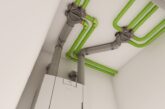
Neil Turner, (UK) Technical Manager at Ecological Building Systems, looks at why natural insulation is becoming an essential part of modern homes.
Natural insulation materials originate from renewable resources, such as wood fibres, sheep wool and jute. They have a significantly lower carbon footprint and a higher sequestered biogenic carbon content compared to conventional insulation options like foam or mineral wool.

Demand for sustainable building materials means many in the building industry are looking at natural fibre insulation as a preferred alternative to other insulation materials, such as mineral wool, polystyrene (EPS & XPS) rigid polyurethane (PUR/PIR) and phenolic foam.
There are many performance benefits associated with natural insulation materials, which are becoming more well known. These include low thermal diffusivity (reduction in summer over-heating, due to a combination of high specific heat capacity, high density and reasonable thermal conductivity), airborne acoustic noise reduction and moisture diffusion openness (breathability). In addition, natural insulation products have better carbon profiles than many other insulation materials.
As well as these performance benefits, natural insulation materials, such as Gutex Multitherm, which is made from recycled wood chips, have a very low cradle to end of life Global Warming Potential (GWP) of 93.36kg CO2 equivalent/m3. Wood fibre insulation can also often be recycled at the end of life and when these impacts are taken into account (Section D of the life cycle assessment) then Gutex Multitherm has a better than carbon zero GWP rating of -91.94kg CO2 equivalents/m3.

Thermal regulation
The thermal mass and humidity-regulating properties of natural insulation can play a crucial role in maintaining comfortable indoor temperatures and reducing the risk of moisture-related issues in a home.
Compared to many other insulation materials, natural fibre insulation has a high specific heat capacity, which when combined with a relatively high density and reasonable thermal conductivity allows the absorption and storage of large amounts of thermal energy. This thermal mass can play a crucial role in mitigating overheating during the summer months, providing a more stable and comfortable indoor environment.
By choosing an insulation material which is naturally able to store large amounts of thermal energy, occupants of a house can benefit from a high level of comfort all year round. Natural wood fibre insulation boards can significantly reduce heat loss in a building during the winter and heat gain during the summer, therefore reducing energy bills. Natural insulation materials also help with acoustics, by absorbing sound waves, which reduces the transmission of noise between different spaces within a building.

Breathability
One of the main characteristics of natural insulation materials is their breathability (low moisture vapour diffusion resistance) and high moisture sorption/desorption properties. This provides more flexibility in designing building elements as there is no requirement for highly moisture vapour resistant barriers. It also prevents the build-up of moisture within the building envelope, reducing the risk of interstitial condensation, mould, rot and other related problems.
In addition to being moisture vapour diffusion open, natural fibre insulation products tend to have a high degree of hygroscopicity. This allows moisture vapour to be absorbed, distributed, stored and then harmlessly released with changing indoor and outdoor climate conditions. This absorption and release of moisture by the insulation also helps regulate temperature fluctuations, therefore providing a more comfortable living or working space.

In terms of design, this breathability allows for greater design flexibility as there is no need to use high vapour resistant Vapour Control Layers throughout the building. In historic renovations or when upgrading thermal performance in solid masonry walls, use of natural insulation can prevent issues with moisture, condensation and mould. They work particularly well with lime-based mortar products to maintain breathability throughout the wall structure.
For modern builds, including Passive House projects, natural insulation materials help buildings to achieve a high level of energy efficiency while maintaining a healthy indoor environment and improving the carbon profile of the building. For that reason, a growing number of Passive House constructions use natural wood fibre boards and airtight racking systems to ensure optimal thermal performance, combined with moisture management within the building.
The installation process for natural insulation is similar to that of other insulation products, with no need for specialised protective gear or complex techniques, therefore reducing health and safety issues on site. Ensuring airtightness can be achieved by sealing joints, using appropriate tapes and sealants. Insulation suppliers should be able to advise on this aspect of the installation.
Fire safety
When it comes to fire safety, natural fibre insulation has clear benefits. Its products char on exposure to flame, which provides protection to the structure and slows down the penetration of heat and flame. It is possible to achieve an REI rating of up to 90 minutes tested from inside and outside according to EN13501-2 (BS476 Part 20-22).
A sustainable insulation solution
While it is true that in some cases the initial cost of natural insulation may be higher than some synthetic options, this perspective often fails to consider the long-term benefits and the potential cost savings associated with these materials. The enhanced thermal and moisture management properties of natural insulation can lead to reduced energy consumption and lower maintenance costs over the lifetime of the building.
When choosing insulation materials, it is important to take into account factors such as heat capacity, breathability, thermal performance acoustics, fire safety and environmental impact.
The increasing demand for more sustainable insulation materials means there is now an insulation material available for most applications and to suit a wide variety of projects.”
For more information on natural insulation materials to create a sustainable build go to the Ecological Building Systems website at www.ecologicalbuildingsystems.com.







